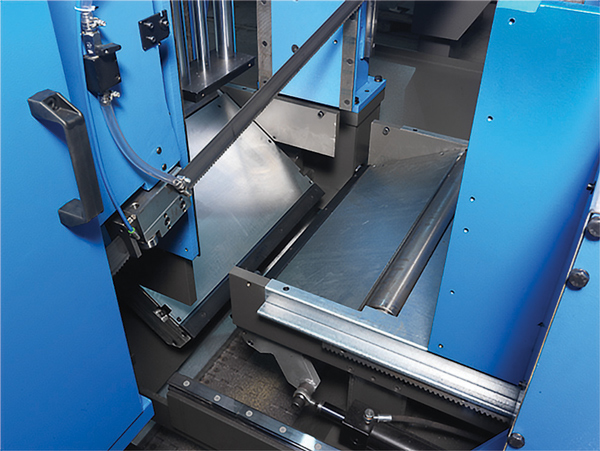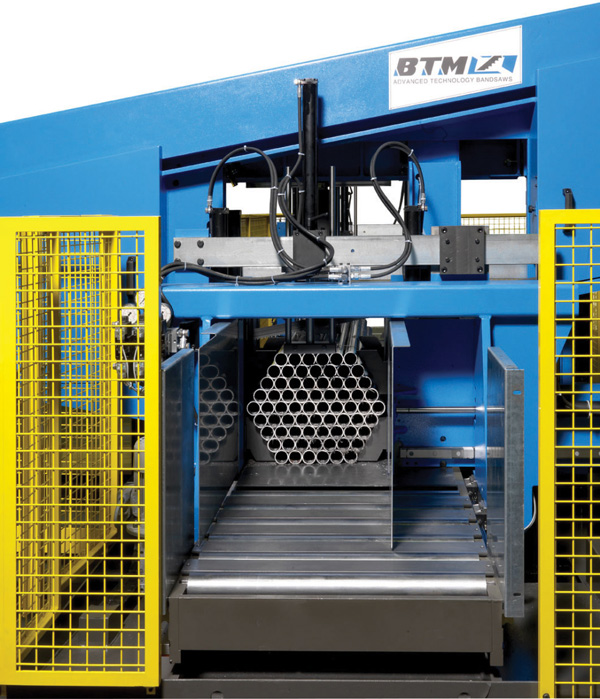unning several bandsaw machines for 100 hours a week or more teaches you that even heavy-duty equipment can get strained at continuous levels of operation. You might want to specify new machines that deliver more power, more control, more precision, more speed and higher quality.
That was the trajectory taken by Sherwyn Greenfield, Iowa facilities manager for Rosenboom. The company—which has factories in Sheldon and Spirit Lake, Iowa; Bowling Green, Ohio; and China—manufactures custom hydraulic cylinders with typical bore sizes from 1 to 12 inches, typical stroke lengths up to 24 feet and operating pressures up to 10,000 psi. In business 45 years, Rosenboom employs 900 people in the United States.
“We build cylinders for OEMs; they are all custom designed and custom built,” Greenfield says. Cylinder lengths range from 6 inches to 40 feet. Applications for Rosenboom’s cylinders include agricultural equipment, construction equipment and aerial trucks.
Rosenboom has operated numerous bandsaws from various makers over the years. More recently, the company purchased two BTM saws, switching due to the “reliability and the speed of the saw design,” Greenfield says.
“We have several different setups. Some of the jobs are more labor intensive. With some others, speed is more important, especially for large volume. We have a class of saws dedicated to that kind of product,” he says.

“It’s huge. We had a saw there, and Sherwyn walks up and talks about makes and models,” says Tatham. “He has five of this model, four of that. I asked him, ‘How many saws do you have?’ He said, ‘We have 50 operating at one time.’ He told me he wasn’t happy with the products he had, and I told him about the features of BTM band saws.”
Tatham says Rosenboom purchased a smaller model first, adding, “They tried it and really liked it.”
Rosenboom uses the smaller saw in an application to cut up to 8-inch-diameter tubes and 4-inch-diameter shafts. The bundle cutting feature will hold 14-inch by 14-inch bundles, Greenfield says. “That may be six tubes or it may be 25 rods.”
Then, “the next project came up,” says Tatham. Greenfield explains that his company won a long-term contract to cut large bundles of tubing for a customer. So the company ordered a second, larger BTM saw.
The smaller saw, he says, is located in an automated work cell, which takes up about 50 by 50 feet of floor space. The saw itself has a 30-foot footprint. “We put 25-foot-long material on that table.”
The larger sawing system features a 25-foot-long infeed table; the saw itself holds material of the same length; and there is a 25-foot-long outfeed table, so the entire line is 75 feet long.
 Consistent squareness is critical. If the cut material is not square, we waste material.
Consistent squareness is critical. If the cut material is not square, we waste material. 
“Quality is one of the biggest reasons we chose BTM. Consistent squareness is critical. If the cut material is not square, we waste material. Using these saws, we can reduce scrap and increase output.
“As we went to look for an alternative saw—due to quality issues and maintenance issues we had with an old saw and the project to cut bundles—we found BTM was easy to work with and they made modifications to fit our process. The amount of control they have over the way the saw cuts is very critical for our application,” says Greenfield.
Another step BTM took was to isolate the blade drive, using a high-quality gearbox, which Tatham says is crucial to extending blade life and providing a better surface finish on cut material.
“With this technology, you buy fewer blades over the life of the machine, which allows you to make more money faster.”
Rosenboom sought a machine with a 24-inch by 28-inch capacity, set up to cut hexagonal and square bundles, while also able to cut to length single pieces. “It’s very flexible,” Tatham says. The machine built for Rosenboom features a 10-degree blade cant, This spreads the cut over the cross section of the work piece, allowing the blade to cut faster and preserve blade integrity.
Again searching for flexibility, Rosenboom specified that it wanted to use the same equipment to cut short pieces, from below 1 inch up to 6 inches long, that would drop through the trap doors and into a bin to be taken to the next operation.
“It’s a very efficient saw that is processing large amounts of steel very quickly,” Tatham says. BTM can build and ship custom saws within eight to 12 weeks because most of it is already built. “All we have to do is fine-tune it to customers’ specifications,” says Tatham. “We install custom features and perform final assembly.” Larger machines are built from the ground up. Delivery may take 15 weeks for a larger custom saw.

Rosenboom, Sheldon, Iowa, 712/324-4854, www.rosenboom.com.